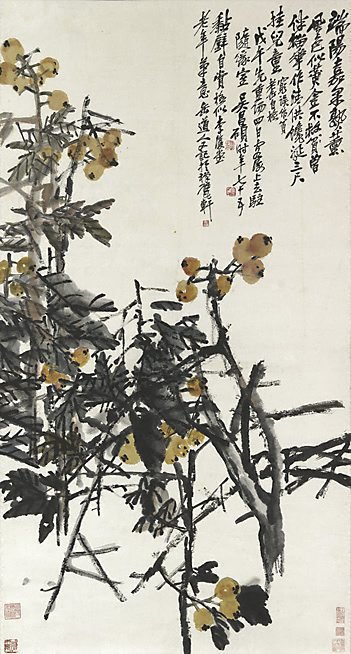-
Details
- Place where the work was made
-
China
- Period
- Republic 1912 - 1949 → China
- Date
- 1918
- Media categories
- Scroll , Painting
- Materials used
- hanging scroll; ink and colour on paper
- Dimensions
- 181.5 x 82.0 cm image; 247.0 x 110.0 cm scroll
- Signature & date
Signed and dated u.r., in Chinese, inscribed in black ink, “…the year of Wuwu (1918)…Wu Changshuo…”
Signed top c., in Chinese, stamped in red ink "Junqing zhiyin [artist's seal]".
Signed upper c., in Chinese, stamped in red ink "Changshuo [artist's seal]".
Signed c., in Chinese, stamped in red ink "Wu Changshuo [artist's seal]".- Credit
- Purchased 1987
- Location
- Not on display
- Accession number
- 460.1987
- Copyright
- Artist information
-
Wu Changshuo
Works in the collection
- Share
-
-
About
‘Wu Changshuo was a poet and a calligrapher before he became a painter and it was association with Ren Bonian that inspired him to become an artist. Wu subsequently became one of the leading figures of the Shanghai school, renowed for the directness, colour and sense of spontaneity of his work. This scroll typifies Wu’s energetic style distinguished by a graphic bravura in both the painting and the calligraphy. Having earlier studied calligraphy and ancient epigraphy Wu had a special appreciation of the opportunities of calligraphy and this is well demonstrated in his wonderful and expressive brushwork. The subject matter of the mature and ripening loquats combined with the sheer energy of the brushwork echo a sense of lively regeneration in the artist, who painted this scroll in his 75th year. The poem, also written by Wu, read:
'During the Duanyang [May 5th festival],
the good fruit ripens with the warm wind,
Though its colour is like yellow gold,
that hardly relieves poverty.
Placed with pomegranate flowers on the table for appreciation.
Three chi of craving saliva hang on the child's mouth."Qiong" is mistakenly written as "pin", Lao Fou self [Wu's sobriquet] checked
In the 'wuwu' year four days before the Chongyang [a festival on the ninth day of September according to the lunar calendar], as a guest in the Qu Zhu Sui Yuan Studio in Haishang [ie Shanghai]
Wu Changshuo at the age of seventy-five.
Hanging on the wall for self appreciation,
Extremely resembling Li Futang's brushwork in his old age.Written again by Foudaoren [Wu's sobriquet] at Chan Pi Xuan [Studio]"
‘The Asian Collections: Art Gallery of New South Wales’. pg.166.
© 2003 Trustees, Art Gallery of New South Wales -
Places
Where the work was made
China
-
Exhibition history
Shown in 5 exhibitions
Chinese Painting, Art Gallery of New South Wales, Sydney, 27 Nov 1991–27 Jan 1992
Art of the brush, Art Gallery of New South Wales, Sydney, 23 Sep 1995–12 Nov 1995
Chinese New Literati Painting, Art Gallery of New South Wales, Sydney, 23 Aug 1997–05 Oct 1997
Glorious, Art Gallery of New South Wales, Sydney, 27 May 2017–06 Jan 2019
The Way We Eat, Art Gallery of New South Wales, Sydney, 03 Apr 2021–13 Jun 2022
-
Bibliography
Referenced in 11 publications
-
Edmund Capon, Orientations, 'Modern Chinese Paintings in the Art Gallery of New South Wales: The Shanghai School and its Impact', pg. 104-109, Hong Kong, Sep 2000, 106 (colour illus.). fig.3
-
Bruce James, Art Gallery of New South Wales handbook, 'Asian Collection: East Asia', pg. 246-287, Sydney, 1999, 260 (colour illus.).
-
McClure Multimedia (Producer), Voices & Visions from China, Carlton South, 2002, (colour illus.). See: Contents: Visual & Performing Arts, Traditional painting.
-
Jackie Menzies, Look, 'Contemporary Art from China', Heidelberg, Sep 1988.
-
Jackie Menzies (Editor), The Asian Collections Art Gallery of New South Wales, 'The Shanghai School and Modern Painting', Sydney, 2003, 166-167 (colour illus.). The colour illus. on page 167 is a detail of this work.
-
Jackie Menzies and Edmund Capon AM, OBE, Asian Collection Handbook, Art Gallery of New South Wales, 'Chinese Painting', pg. 42-52, Sydney, 1990, 46 (colour illus.), 47.
-
Jackie Menzies, Contemporary Chinese Painting, 'Wu Changshuo', Sydney, 1985, 14 (illus.). Cat.no.21-22
-
Jackie Menzies, AGNSW Collections, 'Asian Art - India, South-East Asia, China, Tibet, Korea, Japan', pg. 173-228, Sydney, 1994, 206 (colour illus.).
-
Jackie Menzies, Art of the Brush - Chinese & Japanese painting calligraphy, Sydney, 1995, 13, 14 (illus.). Cat.no.3.7
-
Jacqueline Menzies, Art Gallery of New South Wales handbook, 'Asian', pg. 72-93, Sydney, 1988, 78 (illus.).
-
Public Programmes Department, Art Gallery of New South Wales, Adventures in Asia. An education kit for the Asian gallery, Sydney, 2003, 7 (colour illus.). card no.7
-

